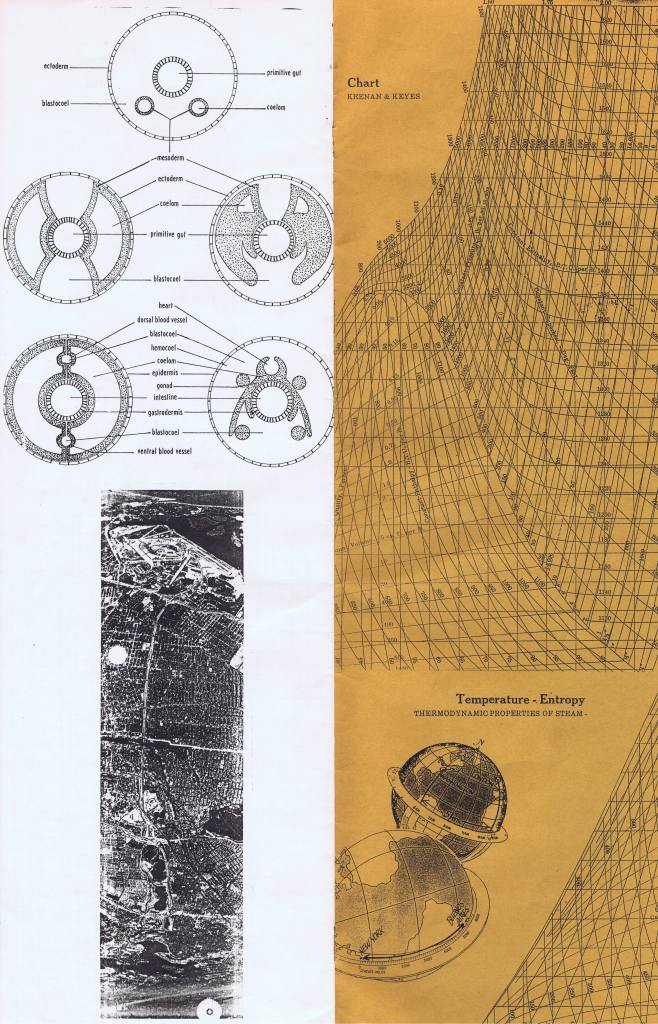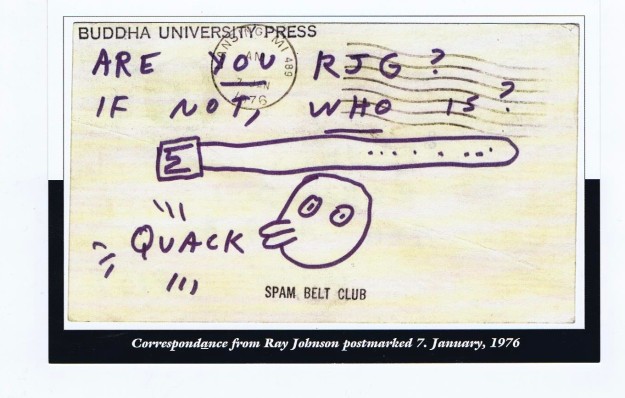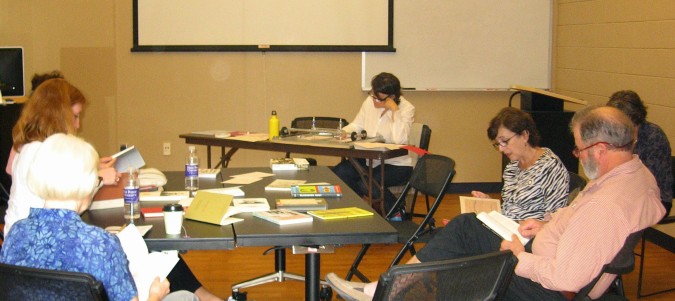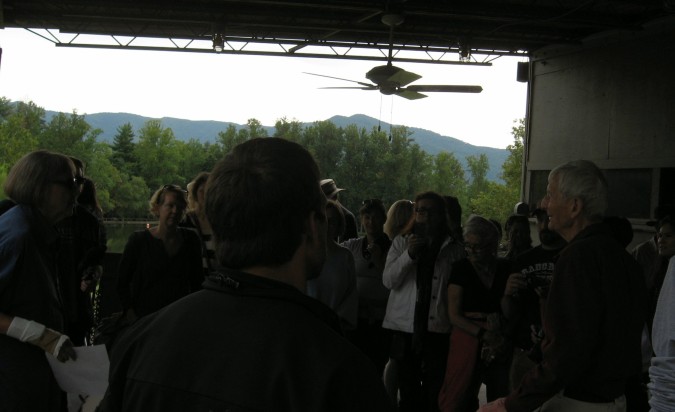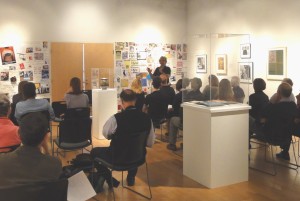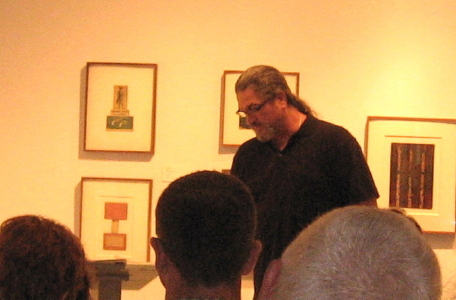Charts of the Universe Culminates After 33 Years
Just completed Charts of the Universe 2020, a collage booklet in an edition of 36. Each one features an original collage, as seen above, with the following image recipe: a wildlife image, a cultural image, Jesus and a redemptive butterfly, a connective ribbon and two different brackets.I have been creating and sending correspondence art since discovering Ray Johnson and his show of mail art at the downtown NC Museum of Art in 1976. Ray responded to the zine I sent him and I was hooked for life.
This series, as with most, including a similar project entitled Science and Truth published soon after the Trump election, looks for resonances between art and science, between data-based visuals and visual aesthetics, locating surprising beauty in graphic information. The current project wraps up the Charts project for me, which began as an installation of assemblages at The Paper Plant bookstore which was accompanied by a chapbook of Chart images. Images of the chapbook are below.
The show of assemblages included over a dozen works, some designed for individual people and a few general ones. Like the final booklet I just mailed, the project was dedicated to Clyde Smith, who took me to that life-changing Ray Johnson show, and Richard C, the curator of that show, who became a friend and correspondent who still sends me his wry and quirky postcards.
Though I will continue to Chart in personal correspondences, this booklet marks the completion of the project and its group pieces. Send me your snail mail and I will add you to my mailing list. You will probably get a Ray J Jumps In, a memorial project that I hope will never end. Cheers to mail art!
Project Updates
The BMCM+AC Fires All Cylinders for Ray J’s Paper Snake Show

Something Else Entirely
Ray Johnson, Dick Higgins + the making of The Paper Snake
The summer 2015 show at the Black Mountain College Museum in Asheville presented newly re-discovered archives of publication material for Ray Johnson’s The Paper Snake, designed and published by Ray’s good friend Dick Higgins in 1965 as the second title from Higgins’ Something Else Press. Curator Michael Von Uchtrup found the production material in a large brown paper envelope among the many items in William S. Wilson’s Ray Johnson archive. The envelope lay unopened for 50 years. The exhibit displays original collages, design proofs, an autographed copy of the very rare first printing, and various related material, including hilarious “promotion flyers” produced by Ray for the book. The show came on the heels of the reprinting of The Paper Snake by Siglio Press in 2014.
“The show is full of mysteries,” stated Von Uchtrup at the opening reception on June 5, 2015. The Paper Snake is nearly as much about Dick Higgins’ “translation” of Ray Johnson’s ideas as it is a record of one stream of Ray’s voluminous sendings. Higgins selected and sometimes altered the material, often to Ray’s dismay. Many of the proof pages and original art for the book showed significant differences from the final book, and a few bits of the text seemed to be written by Higgins. Still, the book and the show are filled with lists, tiny plays, letters, quotes from reading, and all the other unique fusions of art, communication and humor found in Ray Johnson’s work.
This was a show to read more than to view. Though greatly enhanced by several early collages on loan from Bill Wilson, the bulk of the show was devoted to images directly related to The Paper Snake. Large proofs sequenced on the wall enabled one to actually stand and read the book in proof form.The display tables held much dense typescript that usually rewarded closer inspection. A special treat was the audio-visuals: three audio-cassette records of performance works by Ray Johnson, a Dick Higgins poem recitation, and 1965 8mm films of Ray. Even the book selection on the sales shelf offered a wide and valuable range of titles relevant to the show, including of course, the book itself. The reprint was issued in the same print run as the original, 1840 copies. Siglio Press calls it a “vertiginous,mind-bending artist’s book … far ahead of its time.”
The events surrounding the show not only illuminated the book but also presented a fine example of the wonderful work done by the BMCMAC staff and its presenters in providing context and local artistic collaboration to deepen our connection to Black Mountain College. The day after the reception, the curator was joined by Julie J. Thomson for a freely flowing discussion based on slide images of the career and artistic significance of Ray Johnson. Julie has set herself the task of discovering “how one becomes an artist like Ray Johnson,” and her close reading of resonances within the book and her honest embrace of the ambiguity and occasional frustration of dissecting Ray’s inscrutable processes made for a fascinating sharing. Michael Von Uchtrup is working on a biography of Ray, and he emphasized many learnable moments derived from close attention to the materials in his discovery. Julie and Michael’s reminiscences of interviews and anecdotes echoed a strong theme in the documentary film about Ray: no one really knew Ray Johnson, or everyone knew a different side of him. Julie and Michael’s perspectives on the show were offered in full length essays in the large brochure accompanying the show.
On July 3rd, a full audience enjoyed the presentation of “In the Arm of Flowers”, a performance by Megan Ransmeier and Julia Rich. The themes of correspondence, communication over space, and isolation played out in dance movements, readings and evocative vocalizations by the two artists. Their performance was based on three years of correspondence, and was dedicated to Ray’s work. In the exhibit’s final public event Alice Sebrell gave a strong introduction to the screening of “How to Draw a Bunny“, the award-winning 2002 documentary featuring 1995 interviews with Christo, Chuck Close, Roy Lichtenstein and others.
This array of features was capped by the publication of Volume 8 of Black Mountain College Studies, which was dedicated to the 50th anniversary of the publication of The Paper Snake as well as the exhibit under discussion. It includes essays, interviews, and many topics for further exploration. With Sebastian Matthew’s 2010 show on Ray’s early years, the BMCMAC has provided a Ray J fan (and past correspondent) like myself with a rich set of experiences and learning opportunities. This exhibit provided the general and artistic community with another window into the unique and ground-breaking work that emerged from BMC. It took some fairly esoteric and technical materials and turned them into a show and event schedule that provided for a very enriching summer at the BMCMAC.
At BMC Conference, Performances and Activities Rival Academics
Late September 2014 brought the 6th edition of Re Viewing: Black Mountain College, and my experience, as always, was to be re-invigorated with the vast lessons to be learned from attention to the process and people who inhabited that magical place between 1933 and 1957. This year’s conference had writing as its theme, but the over-all thrust of the events took us well beyond the Olson era at the end of the college’s life, which is usually the focus of BMC literary topics.
The conference is sponsored by the Black Mountain College Museum and Art Center, whose reception for an art show of Dan Rice’s work is seen above. The BMCMAC is growing fast, with a growing permanent collection of BMC art and a newly announced expansion in downtown Asheville. Their conference has been held past two years at UNC-A’s Reuter Center, a lifelong learning institute which serves as a slightly cramped but otherwise excellent venue. It was well attended by presenters from across the country, with a small international contingent as well. A special feature of the conference is the appearance of individuals directly connected to the college, and this year’s prize was Ted Dreier, Jr, who spent his childhood there as his father Ted Sr. played a major role in college life and the business/finances of BMC. Ted Jr. shared many stories during the Sunday campus tour. It was also a great pleasure to meet the grandson of John Dewey, whose educational philosophy was a foundation of BMC.
The simultaneous events always means selection and rejection (or sneaking out and listening a bit). I started with electing for a writing workshop with Jeff Davis, who helped inspire the cut-up project pictured at the top of this post. Jeff had us participants write two words on a deck of 52 cards he provided. Then we dealt ten out and built poems with the selection using a couple of different procedures. We were emulating the “procedural writing” process used by BMC alumnus Jonathan Williams in writing his poem “Mahler: for Symphony No. 7 in B Minor.” It was fun and Jeff offered enthusiastic appreciation for the ironies and amusing juxtapositions in the poems as we shared them. Jonathan’s press, Jargon Society, is now under the auspices of the BMCMAC.
The next session also drew me to a decidedly non-academic presentation, where Ted Pope offered his unique brand of performance poetry. After a mesmerizing rendition of intricate classical guitar by his son, Ted set the tone for his own work by whipping his arrangement of antlers on a tree stump. This was followed by several energetic rants, including one that gave BMCMAC vice-chairman J. Richard Gruber “a whole new perspective on my home state of Kentucky.” Ted’s anarchic approach brings to life some of the spirit of the college, but also evokes a rich sense of the mountain man, wily and cultured in his own way, and helps define the sense of place that was a thread throughout the conference.
Mary Emma Harris, preeminent BMC researcher, and Vincent Katz, keynote speaker, focused on the growing international recognition of the importance and value of Black Mountain College studies and the profound model of experiential and self-directed education its history represents. The editors of the upcoming Anthology of Black Mountain College Poetry discussed their criteria, reflecting the strong literary importance of Olson and the Black Mountain poets as well as the diverse examples of good writing that permeated the entire span of the college’s existence. Ray Johnson, my default interest at all conferences, is included in the anthology, and his writing is also featured in two newly published books: a new printing of Paper Snake and Not Nothing: Selected Writings, 1954-1994, both from Siglio Press. I honestly did not attend enough hard core lectures to report on the literary ideas at the conference, but instead continued my trend of taking in the active and participatory opportunities. They continued to be very rewarding.
When I walked into “Notes for Time and Place, an Improvisational Drawing Performance,” I not only did not know what to expect, I did not recognize the mechanism sitting on the presenter’s table. I might have, because I had seen a much earlier version. Mercedes Teixido has arranged the construction of a Jeffersonian copy machine, built in consultation with the curators of Monticello, and she uses this marvelous machine in her art endeavors. We were given written instructions (in duplicate copies), to peruse the Black Mountain College titles spread out on the table, and to read a passage aloud when the impulse struck us. The written “rules” stated that if we read a passage, she would make a drawing, and we could have one. As a group, we took a little warming up but eventually all of the audience read something aloud, and just as with Jeff Davis’s “Chance of Magic” workshop, there were fun juxtapositions with and reactions to the readings.
Mercedes herself just listened and worked quietly. She patiently placed twin sheets of paper into her marvelous machine after each drawing, and after some time she spread out the twin line drawings for display. We were invited to take one of a pair, leaving her with a documentary set. It was a truly unique experience, and we all bonded a bit through listening to each other read. It was one of the best acts of artistic community-building I have ever seen, and highly appropriate to this conference about a college where art and life, the interior mind and the artistic act, were irrevocably entertwined.
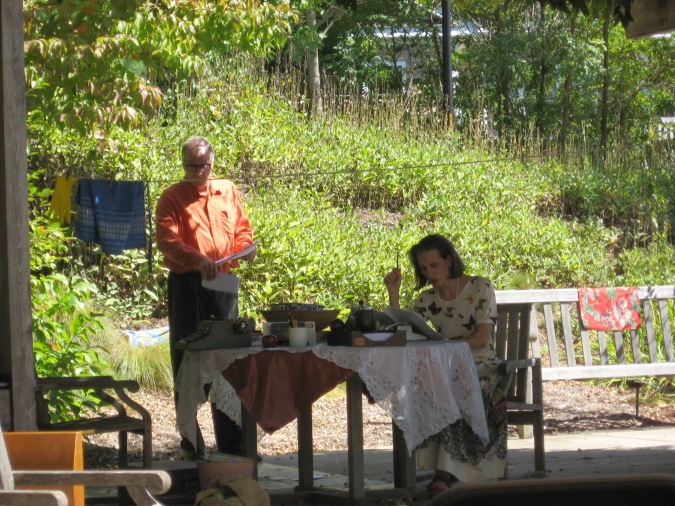
Monika Gross & David Novak stage a reading of selections from the correspondence of Robert Duncan and Denise Levertov
The culmination of my conference experiences came with Re Weaving, a theatrical reading of letters between Robert Duncan and Denise Levertov. Monika’s work attempts to expand our perspective on theater through unusual spaces, modes, or interactions between actors and audience. This performance drew on the powerful phrases of the original exchanges between Duncan and Levertov, but also enacted the spirit of BMC itself with its fresh approach and innovative techniques. The selection, repetition and rhythm of the words built an amazing dynamic between two very powerful and convincing characters ensconced in a stripped down, yet utterly convincing physical set.
This was another performance offered as an alternative to the academic presentations, this one outside on a patio of the Reuter Center, with the readers/actors under a rustic wooden trellis filled with vines. A few simple props (most magnificently exemplified by a manual typewriter) served to evoke the personal spaces of two people who send their thoughts and feelings across the continent. At times, they react in real time to each other’s missives, at times the rapid exchanges represent an argument: there were no limiting rules in the creation of this dialogue. The power of the characters seems enhanced when they take their inner thoughts outside of the defined theatrical space: when David Novak stalks the character of Robert Duncan up the landscaped slope outside the trellis, it is as if he has left the theatrical space but taken us with him, witness to his silent but fully projected thoughts. Monika, who also stepped away as seen above, did her own magic with space, joining the audience and thrusting her hand up like a precocious schoolgirl at the famous Mr. Duncan, asking him the questions that beleaguered this passionate but probably unconsummated intellectual couple. It was a strong, effective and moving performance, honoring and exploring the range of artistic modes that characterize Black Mountain College.
But wait! Hang in there for the BMC campus and farm tour!
For me, the best was last this year. I finally took the Sunday tour, mainly because David Silver had asked me to read for his farm tour and I was thrilled to contribute, in a way however small, to this wonderful event. Mary Emma Harris started us with a tour of the original resort bought by Black Mountain College in 1941. Midway through her exposition of the dining hall and its central role in college life, Ted Dreier, Jr and his wife arrived, and Ms. Harris (as did David Silver later) graciously conceded the speaking stick to this true alumnus of BMC college life, as faculty kid and later as student. He shared wonderful memories about being allowed to sit at meals with students, about the tragedy of his brother’s accidental death and the memorial construction of the Quiet House, and the communal exchange of the bulletin board in the student-constructed Study Hall.
The property purchased by the college is now divided: Camp Rockmount continues to host hundreds of boys each summer, but the upper reaches, including several original cabins and the farm area, still belong to the family who purchased the land from BMC in 1947. The son-in-law of that family, Leigh Maher, is on the BMCMAC board, and joined us for the tour of his part of property.
David Silver followed up his amazing multimedia event at the Hunt Library with a bang-up tour of the farm. He had several people read relevant passages as we stood in front of the barn and silo. Silver’s numerous presentations have made it clear that the the farm was central to the life and very existence of the college, and that its abandonment in the final years not only left the students hungry enough to eat frog legs, but signaled the coming doom of the end. And yet, as Mary Emma Harris said, the real point is that it lasted as long as it did on such precarious financial ground, and lasted long enough to generate waves of students and ideas that permeate American art culture to this day.
BOO KOF KNO WLE DGE – Ray J’s Zen Icons
The BMC conference in October 2010 at UNC-A offered a wide range of wonderful BMC nuggets, but having put off posting about it so long, I’m sticking with the Ray Johnson material which is always my main priority. A big highlight was John Held’s mail art show and talk about mail art and the early days of the NY Correspondance School.
Ray’s inscrutable, radical but disarming approach to art has clearly led to a rich but fairly specialized body of critical writing and thinking about his work, immeshed but not entangled in the large “fan” following evident online. The main points of the former relate to Black Mountain College influences, the main thrust of the latter is mail art and performance art. Ray did not appear to observe such distinctions, but one thing I gained in the last two years of learning from BMCM+AC venues for Ray J work is that Ray Johnson was a major artist in the tradition of DuChamp, Miro, and Klee. Slowly, a body of academic work is relating his truly astonishing accomplishments both in the mainstream tradition of painting and his unique and irresistible gift and mandate: “Steal beauty from the mundane.”
The conference presentations offered delicious details about Ray’s process. Sebastian Matthews provided the quote above as he compared Ray’s obsession with found images to the “image collage” of Frank O’Hara poem “A Step away From Them.” Sebastian also elucidated with great insight about Ray’s Moticos, the secret embeddings and abrupt juxtapositions that Ray created in response to his environment. For Sebastian, Ray is a zen master of art, always indirect though immediate, balancing inward and outward by being aware of the act of being aware. Like O’Hara, a New York School poet, Ray scoured the city for images that enabled him to subvert and reconnect meanings.

Louly Peacock described how Ray subverted Pop Art (and pre-dated Warhol with celebrity portraits), teasing the major figures as in labeling Pollock “Action Jackson,” a nomiker that stuck. Her survey of phallic imagery in Ray’s work made her yet again the most entertaining speaker at the conference. Julie Thomson helped frame Ray’s performance art in showing the relationship between Ray and George Brecht of Fluxus fame, who” began to imagine a more modest, slyly provocative kind of art that would focus attention on the perceptual and cognitive experience of the viewer.” Brecht created “instructions for a toward event,” and along with Alan Kaprow paved the way for the Happenings – not to speak of Ray’s Nothings. Johanna Gosse portrayed Ray as a renegade of the gallery art world, deliberately obfuscating the market process, living in the “osmotic fluid flow” of daily aesthetic experiences, where the experience is the end, the process is the product.
Kate Dempsey revealed more of her discoveries about Albers’ fascination with pre-Columbian culture and how the Mayan hieroglyphs – still mysteries at the time- helped develop Ray’s sensitivity to text as an image source. Ray retained a geometric precision even as he evolved out of painting, and his love of codes, puns and multiple meanings ties together his early and late work.
The best insights into Ray were to be found at the talk by John Held while sorrounded by his mail art show. He walks the walk with mail art to this day and had much to share. He confirmed something also mentioned in the panel discussions – Ray’s moticos were featured in the very first Village Voice in 1955. He also described the importance of the 1970 correspondence art exhibit at The Whitney. He made it convincingly clear that Ray’s correspondence art was “not about the postal system,” but about “how you communicate aesthetics over a long distance.” Held stated that “Ray was building a community,’ and used no judgment or selection with his mailing lists.
The mail art show he exhibited had 170 entries from over 40 countries. It was impressive, entertaining, and a great tribute to the ongoing spirit of the NY Correspondance School. Ray Johnson continues to generate not only interest and academic attention, but exciting participatory tributes and art directly tracable to his genius.
*******************************
One fun event I should share about from last fall is the presentation of a new BMC Wall in downtown Asheville. A large mural and several interesting installations grace an alley just off Broadway.
Several of the writers mentioned above are featured with Ray Johnson articles in an upcoming issue of the
Journal of Black Mountain College Studies
Sebastian Matthew’s Ray J show essay with lots of Ray J images!
Raleigh Rambles Black Mountain page
Raleigh Rambles Ray Johnson page
Ray Johnson Show a Multiple Power Play
“to make open the eyes” Josef Albers All work of Ray Johnson on this site is used by permission of The Ray Johnson Estate
All work of Ray Johnson on this site is used by permission of The Ray Johnson Estate
BMC to NYC: The Tutelary Years of Ray Johnson (1943-1967)
Ray Johnson was probably the most enigmatic and least appreciated artist of his importance in the 20th century. He was a man of many many layers, not so much depth, on first impression, just layers, fairly random factors that underlie and overlay his work. The show just ended at The Black Mountain College Museum and Art Center had many layers itself, over multiple valuable events, and provided a greatly needed showcase and explication for this “seminal figure of Pop Art” whose collages “influenced a generation of contemporary artists.”
The show and especially its catalogue were already reviewed here, but several subsequent events have enriched the impact of the show. Dr. Francis F. L. Beatty (quoted and seen above), a curator who works with the Ray Johnson Estate, gave a lecture at the BMCM+AC on May 21, using parallel slides to show that Ray displays elements in his collages that link him to the major artistic trends of the day. His wit, humor and intense communications of all kinds were highly stimulating but hard to classify, but his collages and the palette he created out of found and encountered material can be seen as fully in the tradition of Klee’ as well as Albers, while partaking of the humor of Dada. “I don’t make pop art. I make chop art.” Ray’s statement refers to his use of old work in new, and Dr. Beatty skillfully elucidated the way in which Ray’s “chop art” (often meticulous geometric constructions) came right out of his Black Mountain experience. She makes a point that reverberated through this show: the liberation of American education happening at Black Mountain served as well to “liberate Ray Johnson.” He found himself, and he found the principle that best illuminates the breadth of his work for me: images standing in for words, words become imagery.
Yet Ray remains enigmatic. Dr. Beatty spent much time on the 55 Moticos – huge intricate collages – which Ray made and destroyed, calling them “some of the earliest and most significant examples of Pop Art.” She recounted many personal interactions with Ray, such as the time he approached her and finally wanted to do a gallery display – of “Nothings.” Beyond his inscrutability, his avoidance of the commercial process, Dr. Beatty makes a simple but important point – the small scale of Ray’s visual work limited his gallery prospects and indirectly his artistic stature.
The scale of Ray’s imagination and willingness to live his life for art was unbounded, of course. The final night of the show, orchestrated by curator Sebastian Matthews, was a truly wild and wonderful event that did much to reflect Ray’s spirit. Music, poetry, and spoken word all filled the space.
“We have to seize the things we need to create.” These words were spoken in Picasso’s voice by Keith Flynt, one of the closing night performers (seen below).
Earl Bragg, seen above, offered a nine-eleven poem that featured number names – worthy of Ray’s glyphs and puns. His political themes and passionate phrases made for an excellent reading.
Local dramatists staged a reading of a collaged piece incorporating Ray’s play inside a play about Ray discussing a play with pink James Dean.
The final word has to go to Sebastian Matthews, who did such a magnificent job not only of putting on the show but of staying in touch with Ray’s spirit the whole time. He evoked and nurtured the image of Ray as filled with humor, energy – and a total lack of any sense of propriety. About the “chop art” and “lost art” which was so prominent in the show, he says: “Ray loved to make things up, kill them off, and resurrect them.”
The Ray show is dead, long live the Ray show.







